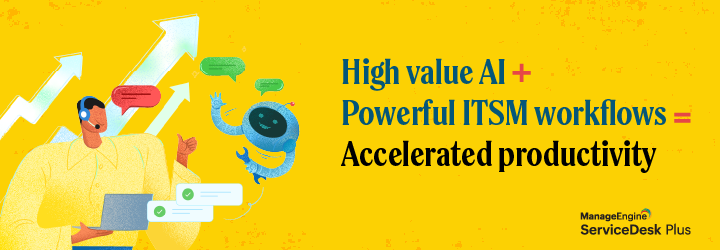“The IT department of every company is going to be the HR department of AI agents in the future.” This statement from NVIDIA’s CEO, Jensen Huang, perfectly captures the dawn of the agentic AI era we are now entering. The rise of artificial intelligence (AI) agents unveils the countless possibilities of an autonomous digital workforce – one that operates with minimal human intervention, adapts to ambiguous dynamic situations, and ultimately redefines how work gets done.
The progress we’ve seen so far in the AI landscape has been nothing short of fascinating – especially in IT. The question for enterprises then becomes: How will Agentic AI agents drive an autonomous approach to IT support and service delivery?
To get the answer, let’s start with the basics.
From deterministic chatbots to autonomous self-driving cars: How did we get here?
What laid the groundwork for what we’re seeing today is traditional AI. By analyzing data and following predefined rules, traditional AI does simple tasks and does them well – but these models are bound to preprogrammed rule sets.
Then, the spotlight shifted to generative AI (GenAI). GenAI models surpass the limitations of traditional AI by learning and recognizing patterns in very large datasets and generating original content that goes beyond the training data to mimic human creativity.
Now, there’s a pivotal evolution – agentic AI. Beyond reactive interactions and constant human involvement, agentic AI takes a step further by acting autonomously, making decisions iteratively, and ultimately achieving goals.

Understanding agentic AI
Think of agentic AI as AI on autopilot. These intelligent systems are designed to go beyond simply suggesting a solution to actually executing it.
For instance, imagine requesting a replacement for a faulty laptop. Today’s virtual support agent could suggest suitable replacement models and provide steps to initiate the request, but it cannot autonomously place a new order or manage the delivery process end-to-end.
However, this changes with agentic AI, which can take action to procure the asset.
Here’s how it would work:
- Perceive, reason, and decide – The agent detects intent and gathers data by checking the warranty status, life cycle stage, and device history. It scours through the asset inventory and finds an available replacement laptop that meets company policies and employee requirements.
- Act – Based on its understanding, if a new laptop needs to be procured, the AI agent can create a service request on behalf of the end-user, generate a purchase request, and communicate with vendors for order placement. It can track invoices, manage logistics, and communicate the tracking status, keeping the employee updated on their laptop’s arrival.
- Learn and adapt – The agent will continuously learn and improve based on feedback and previous interactions to perform tasks faster and more efficiently.
As with all AI agent use cases that we continue to explore, the autonomy these agents would have is adaptive. In this case, the level of autonomy would be dictated by the complexity of the asset procurement process and the AI agent’s access to various data sources, with human supervision required for exceptions, approvals, or any nuanced decisions.
The Agentic AI advantage: Scaling up with multi-agent collaboration and orchestration
One of the revolutionary advantages of agentic AI is the ability to coordinate multiple agents to achieve a broader goal.
Imagine an IT service desk managing thousands of service requests daily. A single AI agent may help automate password resets or help with provisioning software. However, a more complex request like an employee onboarding request would span multiple systems, processes, departments, and approvals. This is where multiple autonomous AI agents, each specializing in a set of tasks, can come into play to achieve the common goal of onboarding the employee.
Instead of relying on predefined workflows that demand human oversight at every step, with agentic AI, the onboarding process can be triggered automatically – whether from a Human Resources Management System (HRMS) tool detecting a new hire, an email request, or a manager simply giving a simple prompt like “Onboard a new employee.” Through intent matching, an onboarding agent, being the orchestrator, can automatically trigger the employee onboarding workflow, routing approvals and notifying relevant teams.
From there, multiple AI agents across IT, HR, and facilities can collaborate in real-time:
- The IT provisioning agent can take over user account setup, adding new employees to the right Active Directory (AD) groups, creating email accounts, and ensuring access to necessary software.
- The people services agent can manage HR onboarding tasks, such as scheduling induction sessions and drafting and sending meeting invites.
- The workspace setup agent can then handle desk allocation and update seating records.
By putting such cross-functional routine processes on autopilot, AI agents allow IT and other teams to focus on more strategic aspects of onboarding while ensuring a smoother experience for new employees.
Balancing autonomy and control: Where do we draw the line?
While these AI agents are the new kids on the block, as with all AI advancements, the technology comes with concerns. One key area that can’t be ignored is security. Enterprises will find themselves at a crossroads, choosing the level of autonomy and control these agents should have. Should these agents have unfettered access to the IT service management (ITSM) solution and other external systems? Should they be able to make decisions and execute tasks fully autonomously? Or should they operate within strict guardrails, requiring human oversight at key decision points?
The key is to strike the right balance while ensuring privacy, security, and accountability. CIOs and IT service delivery managers will also be hard-pressed to align their agentic AI initiatives with emerging legislations like the EU’s AI Act while complying with other frameworks and regulations like ISO 27001, NIS2, PCI DSS, and more.
Are Agentic AI agents the future?
With big players like OpenAI and Google making moves to enable agentic experiences with their own AI agents, it’s only a matter of time before the market becomes saturated with multiple models to choose from.
The agentic era is indeed promising. Work-intensive disciplines like IT support, customer service, and software development will benefit. By undertaking routine and repetitive tasks, AI agents will emerge as enablers that augment human capabilities, allowing employees to focus on more hands-on and creative aspects of their roles.
Alexandria Nisha
Alexandria is a passionate explorer of the ITSM realm and is keen on learning and sharing insights about the ever-evolving ITSM landscape. With a fresh perspective on the world of ITSM, she loves writing best practice articles and blogs that help IT service delivery teams address their everyday service management challenges. In her free
time, you can catch her binge-watching all things Formula 1 and talking about, like her life depended on it, why Lewis Hamilton is one of the best racers ever.

